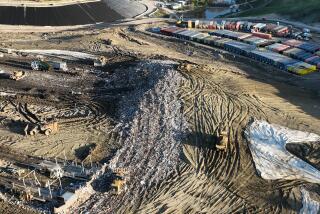Radiation leak forces closure at New Mexico waste burial site
The Energy Department suspended normal operations for a fourth day at its New Mexico burial site for defense nuclear waste after a radiation leak inside salt tunnels where the material is buried.
Officials at the site, known as the Waste Isolation Pilot Plant, or WIPP, activated air filters as a precaution and barred personnel from entering the 2,150-foot-deep repository as they investigate what caused the leak. Radiation sensors sounded alarms at 11:30 p.m. Friday, when no workers were in the underground portions of the plant.
Officials at the site discounted any effect on human health, saying no radiation escaped to the surface. But they said little about the extent of the problem or how it could be cleaned up.
“Officials at WIPP continue to monitor the situation,” spokeswoman Deb Gill said. “We are emphasizing there is no threat to human health and the environment.”
How long the repository would be closed and the effects on the defense nuclear cleanup program were unclear.
The Advanced Mixed Waste Treatment Project, a federal operation in eastern Idaho that is the biggest user of WIPP, said Monday that it had suspended waste shipments.
Gill said the repository shutdown occurred earlier this month after another incident in which a truck caught fire in an underground tunnel. That matter is still under investigation.
Any prolonged shutdown could cause a backup of waste at a dozen nuclear-weapons-related sites across the nation, including Lawrence Livermore National Laboratory in the Bay Area. In 2012, those dozen sites made 846 shipments to the dump, more than two per day. A spokesman at the Idaho operation said it was continuing normal business and storing the waste on site.
WIPP officials have said little about what could have triggered the radiation leak.
Edwin Lyman, a senior scientist at the Union of Concerned Scientists, said he believed the cause most likely involved radioactive material on the outside of a container that was not properly decontaminated. Waste is typically packaged into sealed containers. Any contamination on the outside of the containers normally would be cleaned, Lyman said.
A less probable cause, he said, was a radiological process inside a container that forced material out. WIPP has acceptance criteria for the waste that is supposed to prevent such an accident.
Lyman said the extent of the cleanup operation necessary to get the repository back in operation depended on the intensity and range of contamination in the underground tunnels.
“It could be a mess,” Lyman said. “If there is airborne contamination and it involves plutonium, they are going to need to decontaminate surfaces. If it is in the ventilation system, it could have spread to other areas.”
WIPP is the repository for so-called transuranic waste, which includes plutonium and other artificial elements heavier than uranium. In Idaho, for example, contaminated clothing, tools, wood and paper are bundled in 55-gallon drums, then crushed into 4-inch “pucks.” The pucks are put into massive, lead-lined shipping containers with 3-inch-thick tops and bottoms designed to withstand highway crashes.
The New Mexico repository places the waste inside shafts within an ancient salt bed, which is supposed to collapse around the waste in the future and seal it. The operation began in March 1999.
The nuclear waste sent to WIPP is far less radioactive than the spent fuel or sludge from nuclear weapons production that was intended to go to a dump at Yucca Mountain in Nevada. After technical and political problems with that project, the Obama administration has studied an alternative site. Federal officials had hoped an exemplary record at WIPP would help build support for a more complex high-level repository.
“It hasn’t been a good month for WIPP,” Lyman said.
More to Read
Sign up for Essential California
The most important California stories and recommendations in your inbox every morning.
You may occasionally receive promotional content from the Los Angeles Times.











